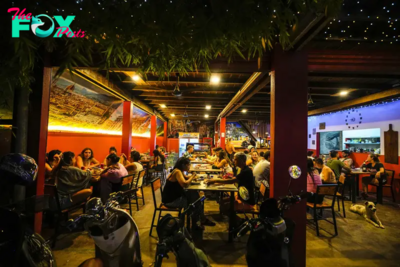World News
Israel’s Past ‘Weaponization’ of Gaza Food Supplies Looms Over World Central Kitchen Deaths
Starvation may well be replacing bombs as the gravest danger in Gaza. But the killing on Monday of seven aid workers demonstrates that the two lethalities can combine to devastating effect. The Israeli government called the deaths of seven staffers for World Central Kitchen “a tragedy.” But as the food aid group—which had rushed into Israel to feed people there after Oct. 7—announced that safety concerns were forcing it to pull out of Gaza, advocates saw additional evidence that Israel is “weaponizing” access to food in an enclave where 1.1 million face danger of famine.
“Israel gives itself license to restrict access to basic necessities, using aid as a tool of war,” says Miriam Marmur, advocacy director of Gisha, an Israeli NGO focused on access to Gaza. “It may be that for some Israeli officials, the starvation we're [now] seeing was never the goal. But within the culture of deep disregard for Palestinian lives, and Israel's ongoing impunity, it's become a spiraling disaster.”
A spokesperson for the Israeli Military office that oversees food deliveries to Gaza did not respond to a request for comment. In a prepared statement, government spokesman Avi Hyman said, "Where there is hunger in Gaza, it is hunger orchestrated by Hamas. ... Today and every day, we are filling Gaza with aid by land, air, and sea."
What's not in dispute is the role food has long played in the coNFLict.
The Gaza Strip, where more than 2 million Palestinians live in an area about twice the size of Washington, D.C., has always relied on imports. The mechanics have changed with the circumstances—from 1948 to 1967, Gaza was controlled by Egypt; following the Six-Day War, Israel occupied the area—but only in 2007 did food become a serious controversy, two years after Israel withdrew its troops and settlers. That was when the militant group Hamas took power and an alarmed Israel imposed a"blockade" on an area that it nonetheless continued to supply with power and water, and, by most readings of international law, remained responsible for.
At that point, almost all food, fuel, and other imports moved by truck through checkpoints controlled by Israel. There were tunnels under the Egyptian border to bring goods, and contraband, but Israel's grip on Gaza's food supply was such that it could reduce the flow when rockets were launched into Israel, and assure the world that Gazans were still being fed even amid concerns that aid was being diverted by Hamas.
Marmur's group 12 years ago uncovered documents showing that from 2007 to 2010 Israel deliberately reduced food imports into Gaza to “minimal subsistence” levels, for a population that then numbered 1.5 million. "The idea is to put the Palestinians on a diet, but not to make them die of hunger," a senior Israeli official at the time, Dov Weisglass, was famously quoted as saying.
"It was right after the pullout from Gaza when unfortunately, the firing of missiles [into Israel] continued," Weisglass told TIME on March 28. He emphasized that the policy has no relevance to the current situation in Gaza, though some possible parallels are evident enough: What finally prompted Israel to ease its first blockade was the international outcry over IDF coMMAndos killing nine activists trying to bring aid and cement to Gaza aboard the Mavi Marmara in May 2010.
Two days after Oct. 7, Israel Defense Minister Yoav Gallant announced a “complete siege on the Gaza Strip. There will be no electricity, no food, no fuel; everything is closed. We are fighting human Animals, and we are acting accordingly.” Six months later, some 1.7 million people have been pushed from their homes, most of which have been destroyed. The 300,000 Palestinians who are most at risk of starvation are living in Gaza's northern half—the area that Israeli forces want cleared. "It appears that there has been an attempt by Israel to starve out the civilian population from the north of Gaza, to create conditions so dire that civilians are forced to go south to feed themselves, thus making it easier for Israel to control that area," Marmur argues, adding that the effort may not flow from the intentions of individual officers, but from an approach demonstrated by the blockade.
Read more: 'Without Empathy, Nothing Works.' Chef José Andrés Wants to Feed the World Through the Pandemic
The latest report assembled by leading international and local aid groups, known as Integrated Food Security Phase Classification, calculates that half of Gaza’s population of 2.2 million have exhausted their food supply and face famine. “People in Gaza are starving to death right now,” Cindy McCain, head of the U.N.’s World Food Program, said on March 18. “The speed at which this man-made hunger and malnutrition crisis has ripped through Gaza is terrifying.”
Major international aid organizations wrote in a letter to the White House on March 26 that "humanitarian assistance has been consistently and arbitrarily denied, restricted, and impeded by the Israeli authorities.” Signed by CARE, Save the Children USA, Doctors Without Borders, International Rescue Committee, and 17 other aid groups, the letter argues that Israel was violating a requirement that recipients of U.S. military aid must follow international law and facilitate humanitarian assistance. Inside Israel, human rights groups made a similar plea to the Supreme Court, arguing in a March 18 petition that the country was violating international law, which obliges Israel both as an occupying power and a combatant to assure aid reaches civilians.
Read more: How Experts Believe Starvation Is Being Utilized in Gaza
Israel’s stated goal in Gaza is to “eliminate” Hamas, which killed some 1,200 Israelis in the Oct. 7 attack and still holds more than 100 hostages. But after killing 32,000 people in Gaza, most of them women and children, in six months of war, Israel has offered no plan for controlling the enclave—or assuring the welfare of its 2.2 million residents. Meanwhile, Israel has discredited UNRWA, the U.N. refugee organization that plays a key role in food distribution, citing evidence that 12 of its 13,000 local employees participated in the Oct. 7 attacks. Attempts to bypass the usual routes for getting food aid into Gaza, such as air drops and even massive deliveries by sea, are unworkable without an orderly system of distribution, but even international aid organizations accustomed to working in war zones, like Mercy Corps and WFP, have been unable to work safely in Gaza.
The death of the World Central Kitchen workers on April 1 is a case in point. Israel has promised a complete investigation of the slaughter, but an account in the leading Israeli newspaper Haaretz offered details from “defense sources":
The aid workers were returning from a food warehouse, not far from a temporary pier built from the rubble of bombed buildings. The three vehicles were clearly marked with the logo of the World Food Kitchen, and Traveling on a route coordinated with the Israeli Defense Forces.
The three-car convoy was hit by three missiles, fired one at a time from the same Hermes 450 drone. After the first strike, survivors clamored into another car in the convoy, which was then hit by a missile. Those who were still alive climbed or were carried into the third car, which was struck by the third munition. At that point, all seven—volunteers from the U.S., Canada, Australia, the U.K., and Poland—were dead.
The drone operators reportedly believed an armed militant was in the convoy. None was.
-

 World News2d ago
World News2d agoLandmark Bill to Ban Children From Social Media Introduced in Australia’s Parliament
-

 World News2d ago
World News2d agoAmerican and Australian Tourists Die in Laos After Drinking Tainted Alcohol
-

 World News3d ago
World News3d agoSee Photos of the Seventh Volcanic Eruption on Iceland’s Reykjanes Peninsula in 12 Months
-

 World News3d ago
World News3d agoMuhammad Yunus on the Race to Build Bangladesh 2.0
-

 World News3d ago
World News3d agoU.S. Charges Indian Billionaire Gautam Adani With Defrauding Investors
-

 World News3d ago
World News3d agoU.S. Vetoes U.N. Resolution Demanding a Cease-Fire in Gaza
-

 World News3d ago
World News3d agoPutin Signs New Doctrine Lowering Nuclear Weapons Threshold in Warning to U.S.
-

 World News3d ago
World News3d agoTens of Thousands Rally at New Zealand’s Parliament in Support of Māori Rights



























